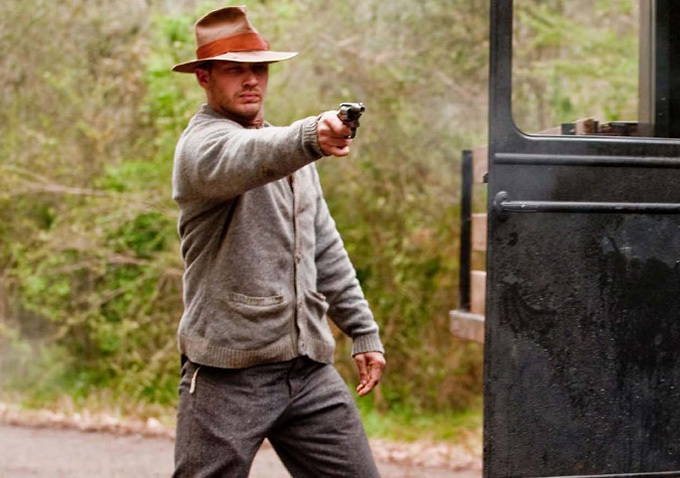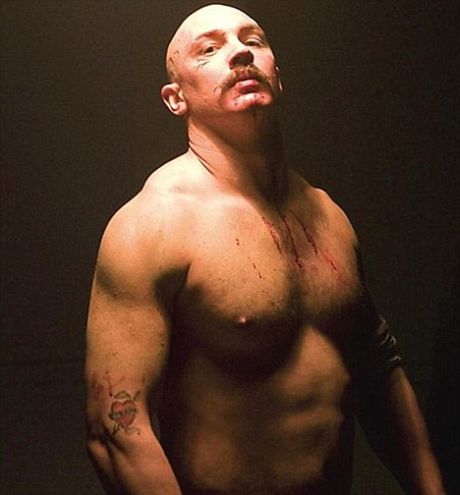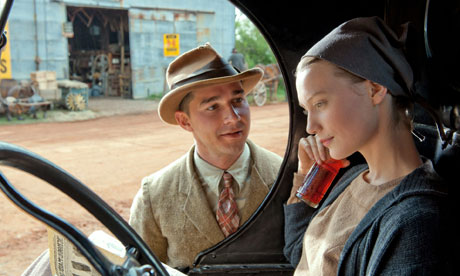 |
| Shoot, Forrest, shoot! The imposing Tom Hardy as Forrest Bondurant in Lawless. |
Hillcoat and Cave collaborated quite impressively on The Proposition (2005), which plays like a combination of Greek tragedy and violent revenge Western , set in the aptly forbidding setting - time as well as dusty space - of 1880's Australia. Cave, usually occupied singing his cheery songs as the leader of The Bad Seeds and Grinderman, also wrote and acted in Hillcoat's first full-length feature, Ghosts...of the Civil Dead (1988).
While Lawless does depict a sanguinary conflict between a resolutely independent family of moonshiners and corrupt law enforcement representatives, it might well have seemed a colorful lark to Hillcoat, whose last project was a grim adaptation of Cormac McCarthy's The Road (2009).
For the film at hand, Cave has adapted the novel, The Wettest County in the World, by Matt Bondurant. Mr. Bondurant is a grandson of Jack, the youngest of the three Bondurant brothers we see in the Lawless. The novel is apparently told from the perspective of the brothers as well as writer Sherwood Anderson, whose characterization of the county during Prohibition and The Depression provides the book's title.
 Cave's screenplay has removed the perspective and presence of Anderson, this imagined Franklin County, Virginia being no place for the meek or bookish. It begins with Jack Bondurant (Shia LaBeouf) speaking in voiceover, setting the scene of Virginia during the 1920's and Prohibition in general, from the renegade moonshiners, whose stills dot the hills at night like so many porch lamps, to the big city gangsters like Capone, who rake in the lion's share of the profits. Jack also speaks of his eldest brother Forrest, who has come to think himself invincible after surviving both World War I and the subsequent pandemic of the Spanish Flu while virtually everyone around him fell. It is an aegis of invincibility which Forrest applies to the entire Bondurant clan and one which apparently intrigued the Lawless screenwriter.
Cave's screenplay has removed the perspective and presence of Anderson, this imagined Franklin County, Virginia being no place for the meek or bookish. It begins with Jack Bondurant (Shia LaBeouf) speaking in voiceover, setting the scene of Virginia during the 1920's and Prohibition in general, from the renegade moonshiners, whose stills dot the hills at night like so many porch lamps, to the big city gangsters like Capone, who rake in the lion's share of the profits. Jack also speaks of his eldest brother Forrest, who has come to think himself invincible after surviving both World War I and the subsequent pandemic of the Spanish Flu while virtually everyone around him fell. It is an aegis of invincibility which Forrest applies to the entire Bondurant clan and one which apparently intrigued the Lawless screenwriter. As Forrest Bondurant, English actor Tom Hardy has added another figure to his growing gallery of cinematic ultimate fighters. With shaved head, bulging muscles, a maniacal handlebar of a mustache and considerable theatricality, he portrayed Britiain's most notorious inmate in Bronson (2008). More recently, he was the terrorizing, formidable bulk making Batman's life miserable as the masked Bane in The Dark Knight Rises. This is not to mention his role as an MMA fighter in Warrior (2011), which I've not seen. Hardy is a more versatile actor than this lineup of tough guys might suggest. With each of the aforementioned roles, the considerable physical presence is matched by a distinct voice (literally and figuratively). In the case of Forrest's literal voice, it's a deep croak which only occasionally and reluctantly transmits itself into verbiage. Mr. Hardy gets considerable mileage out of these low, rumbling blue notes, communicating authority, menace, even (most amusingly) discomfiture, as when the beautiful Maggie Beauford (Jessica Chastain) approaches his bed one night.
 |
| Mr. Bronson, meet, uh...Mr. Bane. Two of Tom Hardy's less genial bruisers in Bronson and The Dark Knight Rises. |
Mr. Hardy has certainly created a very watchable character in Forrest Bondurant. It's easy enough to believe that the big guy in the cardigan sweater and fedora could take a bullet. Or several. But how Hardy's characterization might relate to an actual rural Virginian of the 1920's or 30's is a more dubious matter. And that's really the crux of this latest collaboration by Hillcoat and Cave.
The Lawless screenwriter has said in an interview for the film that "...it's not so such a true story as a true myth." The Proposition might not have been cinema verite, but it still carries more weight, it bears emotional investment that Lawless does not, despite the common, blood-soaked ground. The South of Lawless is still very much a movie South, perhaps even more than a mythical one. It's not such a genial cinematic Dixie as something like Get Low, the Robert Duvall vehicle from 2009. Blood is shed; there is a brutal logic at work to violent men at conflict. For Hillcoat and Cave to spare the rod (the fist, the knife, the gun, what have you) it would seem, is to spoil the fun.
Adding to the violence and entertainment value, if not the wavering connection to reality is Guy Pearce as Special Deputy Charlie Rakes. Looking like Hell's maitre d', Rakes arrives one day to inform the Bondurants and other producers of the local white lightning that he will expect a cut of their profits. Forrest, of course, does not take kindly to this demand. It's not quite clear at whose behest Rakes has arrived, whether some crime boss, J. Edgar Hoover, or Beelzebub. But the man has quite a presence. Pearce's hair, blackened, closely shorn and slicked back, is ruthlessly parted down the middle. He's very much the dandy, but that's not something you want to say in his presence. The wee Cricket, friend to the Bondurants, makes the mistake of simply confirming that some about Franklin Count had commented on Rakes' fastidiousness as it relates to clothing and toilette. "I'm no Nacy Boy!" Rakes exhales murderously at poor Cricket, as he yanks him aside after the unfortunate boy's capture at a raid on the Bondurant's stills.

At first appearance, Guy Pearce is a almost unrecognizable as the slightly jowly Rakes. But that chameleonic ability has long served Pearce well, one of the reasons he's always such an interesting actor. As it turns out, one can also be rendered rather demonic-looking, not only by the arching of eyebrows, but by their near removal. Something to keep in mind perhaps as you make your Halloween costume preparations. The almost complete lack of eyebrows on Rakes gives Pearce's face a preternaturally scrubbed look, as if there can be no masking the malevolence teeming just below that unsettling surface.
 |
| NOT a nancy-boy! Guy Pearce as eevil Deputy Rakes. |
Like so much about Lawless the casting is curious, but usually fun to watch. Another Aussie (as with Mr. Pearce), Jason Clarke plays the middle brother, Howard Bondurant. Less prone to action than Forrest, Clarke's Howard does bring a rabid intensity to any conflict that rouses his interest. Gary Oldman makes brief but memorable appearances as gangster Floyd Banner, back on the fun side of the law after putting in time as the good guy Sergeant Gordon in the three most recent Batman films. Banner appears early on to lay waste a rival after skidding to a halt in Franklin County, peppering his victim with a Tommy Gun to the admiration of young Jack, who witnesses the shooting. Banner, who eventually sides with the Bondurants in the battle against the forces of Deputy Rakes, is supposedly based in Chicago. Another of Lawless' curious evocations of geography is to make Chicago and rural Virginia seem about 30 miles apart, as when Jack and Cricket head out to deliver some of the family moonshine to the big city, using the powerful liquor for fuel once their truck runs out of gas, yet still arriving with a full load. Clearly there's some sort of cosmic superhighway being plied, which brings Maggie Beauford to Virginia. Jessica Chastain's beauty and colorful wardrobe are explained by her being late of Chicago, fleeing her dancer's life and big city chaos. Still, she seems as visually out of place as a visitor from another galaxy. Or Deputy Rakes.
There has obviously been an attempt to bring elements of both beauty and ugliness together in Lawless, as with Maggie Beauford compared to some of the more gruesome locals. This is also true of Benoit Delhomme's cinematography, mixing some of the less-than-pretty people and interactions with much more lyrical sweeps of camera. This happens usually with landscape, rural Georgia standing in for 1920's Virginia for the film's production. But occasionally characters are captured in painterly fashion, as when Bertha Minnix, daughter of the local German Baptist minister and object of young Jack Bondurant's affections, is seen briefly inside her father's truck. Mia Wasikowska as Bertha in that moment looks like something out of Vermeer.
Altogether, what we have with Lawless is an entertaining if not terribly credible vision of Fraklin County, Virginia during Prohibition. But it's not without its aesthetic pleasures. This extends from the people on both sides of the camera to the Lawless soundtrack, which achieves the sort of time-traveling felicity toward which the film falls short. Compiled by Cave and Warren Ellis, it features the pair (with other musicians as The Bootleggers) performing songs both old and relatively contemporary, along with guest vocalists. To hear the great Ralph Stanley perform Lou Reed's "White Light/White Heat" over the closing credits would justify almost anything that preceded it.
 |
| The myth of invincibility being put to the test in Lawless. |
db




Comments
Post a Comment